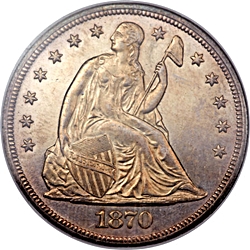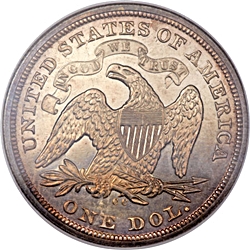 |
1870-CC
 

|
 |
General Comments
|
| |||||||||||||||||||
Die Numbering
Please note that we’ve changed die references since our article in the Spring, 2015 issue of the Gobrecht Journal (reference 10). We re-ordered the dies to reflect our current estimate of the emission sequence. As will be discussed later in this section, there is still some uncertainty in this sequence, but we think we’re close. The table below cross-references our new die identifiers with work done previously. We’ve frozen these identifiers based on our current estimate of the emission sequence. If we later determine that our emission sequence needs to be modified, we’ll change the table that appears later in this section rather than making additional changes to the die identifiers.
Osburn-Cushing (Spring, 2015) |
New Obverse Die ID |
New Reverse |
Kroon ID |
Schlosser ID |
| Obverse 4 | 1 | |||
| Obverse 1 | 2 | 1 | 1 | |
| Obverse 3 | 3 | 3 | ||
| Obverse 2 | 4 | 2 | 2 | |
| Reverse B | A | 3 | ||
| Reverse C | B | 1 | ||
| Reverse A | C | 2 | ||
| Reverse F | D | |||
| Reverse D | E | 4 | ||
| Reverse E | F |
Mintage by Date
The table below summarizes the mintage of 1870-CC dollars by date. This information was obtained from R. W. Julian’s article in the Gobrecht Journal (reference 22).
Minting Period |
Date |
Mintage |
| 1 | 2/10/1870 | 2,303 |
| 2 | 2/24/1870 | 1,444 |
| 3 | 3/05/1870 | 1,116 |
| 4 | 3/22/1870 | 1,175 |
| 5 | 3/24/1870 | 500 |
| 6 | 3/30/1870 | 1,300 |
| 7 | 4/07/1870 | 500 |
| 8 | 5/20/1870 | 600 |
| 9 | 6/11/1870 | 870 |
| 10 | 6/14/1870 | 550 |
| 11 | 6/30/1870 | 1,400 |
1870-CC Die Marriages
Four different obverse dies were paired with 6 reverse dies to create 9 die marriages. The following table summarizes the known die combinations:
Click the links below to view the details of the die marriages.
Die Marriage |
Rarity |
Obverse Die |
Reverse Die |
Estimated Survivors |
| OC-1 | R4- | 1 | A | 170 |
| OC-2 | R5 | 2 | A | 60 |
| OC-3 | R5+ | 2 | B | 45 |
| OC-4 | R7- | 3 | C | 10 |
| OC-5 | R5+ | 3 | B | 45 |
| OC-6 | R5+ | 3 | D | 45 |
| OC-7 | R5 | 2 | D | 60 |
| OC-8 | R4+ | 2 | E | 115 |
| OC-9 | R4- | 4 | F | 200 |
A few other die combinations have been reported, but those noted here are the only ones that we’ve confirmed. This is a year that has been studied enough to allow some level of attribution of die marriages, particularly by auction houses, for many years. However, our review of just the Heritage auction archives revealed that there has been a lot of confusion in these attributions. This is to be expected with so many combinations and several dies that exhibit very similar diagnostics. Also note that two of these dies, one obverse and one reverse, were only recently identified through our research in preparing this website and the first edition of our book (see reference 10). They were not known to previous authors. We hope that our book and web site help to eliminate some of this confusion.
The article discussed previously by R. W. Julian (reference 22) showed that 1870-CC dollars were minted on at least 11 different occasions. This is a possible explanation for the unusually large number of die marriages identified for the year. It’s also an indication that other die combinations could exist. We solicit information from anyone who believes that they own or have seen a die combination not noted here.
1870-CC Emission Sequence
The dies used for 1870-CC didn’t strike many coins. As a result, there was very little degradation over their
lifetimes, making the determination of the emission sequence very difficult. However, one piece of information
only recently discovered has greatly increased our confidence in the accuracy of the sequence documented below.
Obverse 1 was shipped to San Francisco in the spring of 1870 and used to strike 1870-S dollars (see reference
21). This makes it certain that it was used early in the year, which fits perfectly with the sequence that
we’ve documented. Also note that we’ve moved OC-9 to the first position in the sequence, fitting it’s status
as the most common die marriage with the fact that the largest mintage of 1870-CC dollars was on the first date
of issue, February 10, 1870. This is a change from what we documented in the first edition of this reference.
Emission Order |
Die Marriage |
Comments |
| 1 | OC-9 | Placement of OC-9 in the emission sequence is arbitrary since no dies are shared with other die marriages. We’ve assumed that it occupies the first position in the sequence since this is the most common die marriage and the first mintage period, February 10, 1870, produced by far the largest number of 1870-CC dollars (see the tabledocumenting mintage by date). |
| 2 | OC-1 | Since Obverse 1 was used in San Francisco in May, 1870 it had to be used early in the sequence. |
| 3 | OC-2 | Based on Reverse A die polishing OC-1 precedes OC-2. |
| 4 | OC-3 | Based on Obverse 2 die polishing OC-2 precedes OC-3. |
| 5 | OC-4 | OC-4, OC-5, and OC-6 are ordered based on progressive die polishing of Obverse 3. |
| 6 | OC-5 | OC-4, OC-5, and OC-6 are ordered based on progressive die polishing of Obverse 3. OC-5 was issued after OC-3 based on Reverse B die polishing. |
| 7 | OC-6 | OC-4, OC-5, and OC-6 are ordered based on progressive die polishing of Obverse 3. |
| 8 | OC-7 | OC-7 follows OC-6 based on Reverse D die polishing. |
| 9 | OC-8 | OC-8 follows OC-7 based on polishing of Obverse 2. |
1870-CC Quick Finder Chart
With 9 different die marriages currently identified, and the possibility that other die combinations may exist,
attribution can be at least a minor challenge. However, the presence of a mintmark simplifies the process
considerably. Use of the following chart should allow relatively quick identification of most examples.
Die Marriage |
Obv Die |
Rev Die |
Right |
Keys |
| OC-1 | 1 | A | RE | Obverse: High date, RB of 1 is RE. Eyelash obverse. Reverse: Wide CC. |
| OC-2 | 2 | A | JL of C | Obverse: High date, RB of 1 is JL of C. Reverse: Wide CC. |
| OC-3 | 2 | B | JL of C | Obverse: High date, RB of 1 is JL of C. Reverse: Close CC. No die line from feather tip. |
| OC-4 | 3 | C | JL of RE | Obverse: High date, RB of 1 is JL of C. Reverse: Wide CC. |
| OC-5 | 3 | B | JL of RE | Obverse: High date, RB of 1 is JL of C. Reverse: Close CC. No die line from feather tip. |
| OC-6 | 3 | D | JL of RE | Obverse: High date, RB of 1 is JL of RE. Reverse: Close CC, die line goes left from lower tip of upper feather. |
| OC-7 | 2 | D | JL of C | Obverse: High date, RB of 1 is JL of C. Reverse: Close CC, die line goes left from lower tip of upper feather. |
| OC-8 | 2 | E | JL of C | Obverse: High date, RB of 1 is JL of C. Reverse: Medium wide CC. Seen with and without 60 degree die rotation. |
| OC-9 | 4 | F | RE | Obverse: Centered date. Reverse: Medium wide CC. |
| Photo credits:
Obverse and reverse full photos: 1870-CC NGC MS64, tied for finest known, ex. Gene Gardner, from the Heritage archives. |
